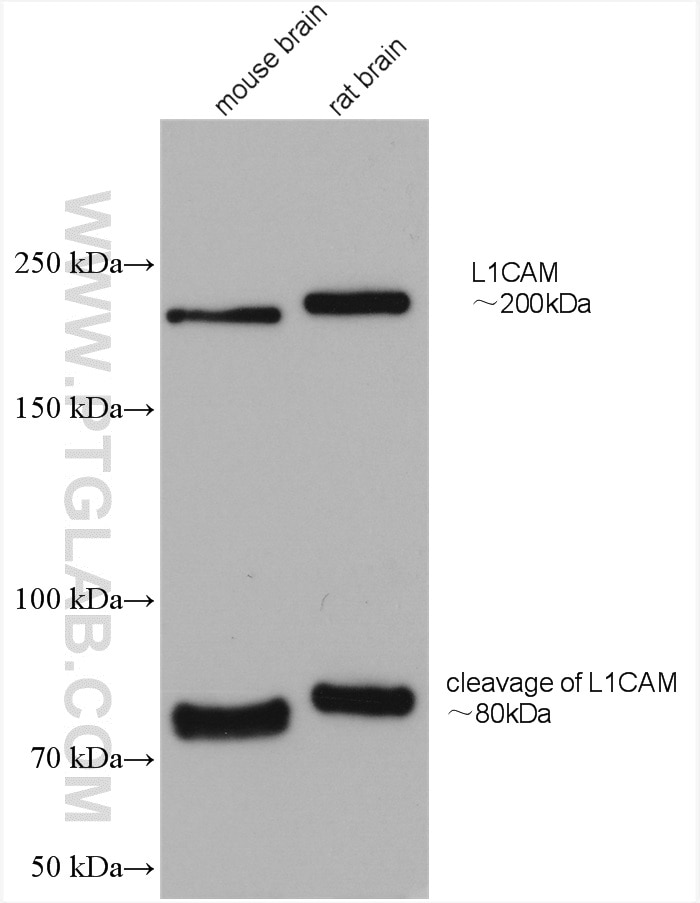Anticorps Polyclonal de lapin anti-L1CAM/CD171
L1CAM/CD171 Polyclonal Antibody for WB, ELISA
Hôte / Isotype
Lapin / IgG
Réactivité testée
Humain, rat, souris
Applications
WB, IHC, ELISA
Conjugaison
Non conjugué
N° de cat : 20659-1-AP
Synonymes
Galerie de données de validation
Applications testées
| Résultats positifs en WB | tissu cérébral de souris, tissu cérébral de rat |
Dilution recommandée
| Application | Dilution |
|---|---|
| Western Blot (WB) | WB : 1:500-1:2000 |
| It is recommended that this reagent should be titrated in each testing system to obtain optimal results. | |
| Sample-dependent, check data in validation data gallery | |
Applications publiées
| WB | See 3 publications below |
| IHC | See 1 publications below |
Informations sur le produit
20659-1-AP cible L1CAM/CD171 dans les applications de WB, IHC, ELISA et montre une réactivité avec des échantillons Humain, rat, souris
| Réactivité | Humain, rat, souris |
| Réactivité citée | Humain, souris |
| Hôte / Isotype | Lapin / IgG |
| Clonalité | Polyclonal |
| Type | Anticorps |
| Immunogène | Peptide |
| Nom complet | L1 cell adhesion molecule |
| Masse moléculaire calculée | 140 kDa |
| Poids moléculaire observé | 200-220 kDa, 80 kDa |
| Numéro d’acquisition GenBank | NM_000425 |
| Symbole du gène | L1CAM |
| Identification du gène (NCBI) | 3897 |
| Conjugaison | Non conjugué |
| Forme | Liquide |
| Méthode de purification | Purification par affinité contre l'antigène |
| Tampon de stockage | PBS with 0.02% sodium azide and 50% glycerol |
| Conditions de stockage | Stocker à -20°C. Stable pendant un an après l'expédition. L'aliquotage n'est pas nécessaire pour le stockage à -20oC Les 20ul contiennent 0,1% de BSA. |
Informations générales
L1CAM, also known as NCAM-L1 or CD171, is a cell adhesion molecule of the immunoglobulin superfamily. It is a 200-220 kDa transmembrane glycoprotein composed of six Ig-like domains and five fibronectin type III repeats followed by a transmembrane region and a highly conserved cytoplasmic tail (PMID: 3412448; 22796939). L1CAM is primarily expressed in the nervous system and is involved in neuron-neuron adhesion, neurite fasciculation, outgrowth of neurites, cerebellar granule cell migration, neurite outgrowth on Schwann cells and interactions among epithelial cells of intestinal crypts (PMID: 3412448; 10767310). L1CAM is overexpressed in many human cancers and is often associated with bad prognosis (PMID: 27267927; 26111503). It has been reported that L1CAM can be proteolytically cleaved into a soluble fragment of 140 kDa and an intracellular fragment of 80-85 kDa (PMID: 30842511; 34380733). This antibody raised against 1206-1221aa of human L1CAM detects 200-220 kDa full-length L1CAM and 80-kDa cleaved fragment of L1CAM.
Protocole
| Product Specific Protocols | |
|---|---|
| WB protocol for L1CAM/CD171 antibody 20659-1-AP | Download protocol |
| Standard Protocols | |
|---|---|
| Click here to view our Standard Protocols |
Publications
| Species | Application | Title |
|---|---|---|
Histopathology Frequent KRAS mutations in oncocytic papillary renal neoplasm with inverted nuclei. | ||
Diagnostics (Basel) Circulatory Astrocyte and Neuronal EVs as Potential Biomarkers of Neurological Dysfunction in HIV-Infected Subjects and Alcohol/Tobacco Users. | ||
Anal Chem Nanosensor-Driven Detection of Neuron-Derived Exosomal Aβ42 with Graphene Electrolyte-Gated Transistor for Alzheimer's Disease Diagnosis | ||
Res Sq Curcumin enhances elvitegravir concentration and alleviates oxidative stress and inflammatory response | ||
Sci Rep Curcumin enhances elvitegravir concentration and alleviates oxidative stress and inflammatory response |


